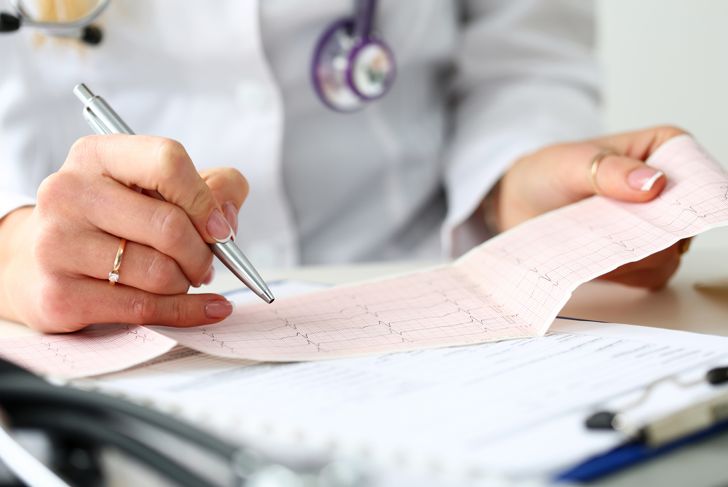A silent heart attack or unrecognized myocardial infarction is a heart attack that is not initially detected but is later identified. The exact prevalence is not known, but some estimate suggest this type accounts for between a third and a half of all heart attacks.Often, people who experience a silent heart attack attribute their symptoms to something else. Knowing what to look for is important to ensure prompt medical attention and necessary follow-up care.
Causes
The causes of a silent heart attack are the same as the causes of any myocardial infarction. Plaque forms in the arteries, causing clots. These clots prevent oxygen-rich blood from getting to the heart.The significant difference with a silent heart attack is that the person is less likely to recognize that they need medical attention. For this reason, silent heart attacks have a higher risk of heart failure.
Discomfort
Silent heart attacks cause the same type of damage as any other heart attack, but they have different symptoms. Some heart attacks have symptoms that include sudden and intense crushing chest pain and shortness of breath, but in a silent heart attack, this pain may be similar to heartburn or mild pressure.People experiencing a heart attack may also have discomfort in other body parts, including the arms, back, jaw, or stomach. In a silent heart attack, this pain is likely to be less intense.
Other Symptoms
Other symptoms of a silent heart attack include difficulty breathing or shortness of breath from everyday activities, like walking up the stairs, making the bed, or walking the dog.This shortness of breath can occur with or without chest pain. Cold sweats and nausea are also signs of a silent heart attack, but may mimic those of the flu. In some cases, the only symptom is feeling a bit under the weather.
Risk Factors
The risk factors of a silent heart attack are the same as those for any heart attack. They include being overweight, eating foods high in salt and unhealthy fats, and having high blood sugar, cholesterol, or blood pressure.People who have a family history of heart disease or who have had COVID-19 are at higher risk, as are men over age 45, women over 55, and people with Native American, Mexican American, and Hawaiian ancestry.
How They Are Discovered
Because most people do not know they are having a silent heart attack, they are often not discovered right away. Weeks or months later, they may be at the doctor for something else and report ongoing symptoms, like shortness of breath or fatigue.Silent heart attacks are likely to result in scarring of the heart muscle or heart valve dysfunction and lead to significant complications. Doctors often diagnose the silent heart attack after investigating these symptoms reported long after the fact.
Diagnosis
Diagnostic procedures for a heart attack include an EKG to detect and record the electrical activity in the heart to assess signs of damage and blood tests to measure proteins that indicate heart damage. The doctor may order a coronary angiography, where a dye is injected into the bloodstream and special x-rays assess blood flow through the heart.Because most people do not realize they are having a silent heart attack, they are not diagnosed quickly, but a physician may perform the same tests even if months have passed.
Initial Treatment
If someone suspects they are having a silent heart attack, initial treatment may include aspirin to prevent clotting, oxygen therapy, and nitroglycerin to improve blood flow through the heart and reduce its workload.Doctors may also inject clot-busting medications to dissolve any blockages or perform a coronary angioplasty; in this procedure, a catheter is inserted into the femoral artery, threaded to the heart, and used to open any blockages.
Ongoing and Post-Treatment
After a heart attack, there are many ongoing treatments that help prevent another one. Doctors may prescribe medications to lower blood pressure, prevent clots, and decrease the workload of the heart. In some cases, people need a bypass graft after a heart attack: the surgeon connects a healthy vein or artery to bypass the blocked section of the coronary artery.
Prognosis
After someone has a heart attack, they are at higher risk of having another. This is especially dangerous for people who have experienced a silent heart attack, as they may not know that they had one. The symptoms of a second heart attack may not be the same as the first. Many people wait too long to call for help.If in doubt, don’t wait. Any delay can result in significant heart damage or even death.
Reduce Risks
Some lifestyle changes can lower the risk of a silent heart attack. These include eating healthy foods, smoking cessation, maintaining a healthy weight, and managing stress.Some medical issues also increase the risk of a silent heart attack, including diabetes, kidney problems, peripheral artery disease, high blood pressure, and high cholesterol. Managing these problems can help prevent a heart attack.

 Home
Home Health
Health Diet & Nutrition
Diet & Nutrition Living Well
Living Well More
More




















